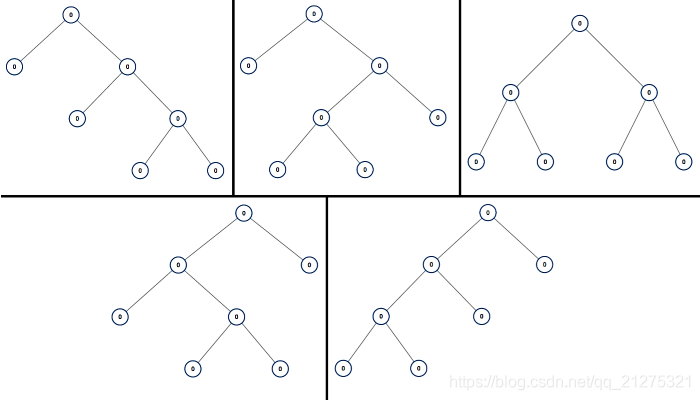894. All Possible Full Binary Trees(python+cpp)
阿新 • • 發佈:2018-11-16
題目:
A full binary tree is a binary tree where each node has exactly 0 or 2 children.
Return a list of all possible full binary trees withNnodes. Each element of the answer is the rootnodeof one possible tree.
Each node of each tree in the answer must havenode.val = 0.
You may return the final list of trees in any order.
Example 1:
Input: 7 Output: [[0,0,0,null,null,0,0,null,null,0,0],[0,0,0,null,null,0,0,0,0],[0,0,0,0,0,0,0], [0,0,0,0,0,null,null,null,null,0,0],[0,0,0,0,0,null,null,0,0]]Explanation:

Note:
1 <= N <= 20
解釋:
返回N個結點能構成的所有的滿二叉樹的形式。
滿二叉樹:要求所有的結點都有0個或者2個葉子結點。
完全二叉樹:若設二叉樹的深度為h,除第 h 層外,其它各層 (1~h-1) 的結點數都達到最大個數,第 h 層所有的結點都連續集中在最左邊。
(1)所有的葉結點都出現在第k層或k-l層(層次最大的兩層)
(2)對任一結點,如果其右子樹的最大層次為L,則其左子樹的最大層次為L或L+l。
也就是完全二叉樹比滿二叉樹的形式更加集中。
需要注意的是,如果N是偶數,則一定不能構成滿二叉樹。
python程式碼:
# Definition for a binary tree node.
# class TreeNode(object):
# def __init__(self, x):
# self.val = x
# self.left = None
# self.right = None
class Solution(object):
def __init__(self):
#記憶化一下,因為會有很多重複計算
self._dict={1:[TreeNode(0)]}
def allPossibleFBT c++程式碼:
/**
* Definition for a binary tree node.
* struct TreeNode {
* int val;
* TreeNode *left;
* TreeNode *right;
* TreeNode(int x) : val(x), left(NULL), right(NULL) {}
* };
*/
#include <map>
using namespace std;
class Solution {
public:
//記憶化
map<int,vector<TreeNode*>>_map;
Solution()
{
TreeNode* tmp=new TreeNode(0);
_map[1]={tmp};
}
vector<TreeNode*> allPossibleFBT(int N) {
vector<TreeNode*>result;
if (N<=0|| N %2==0)
return result;
if (_map.count(N))
{
return _map[N];
}
for (int l=1;l<N;l+=2)
{
vector<TreeNode*> left_list=allPossibleFBT(l);
vector<TreeNode*> right_list=allPossibleFBT(N-1-l);
for (auto left:left_list)
{
for(auto right:right_list)
{
TreeNode* root=new TreeNode(0);
root->left=left;
root->right=right;
result.push_back(root);
}
}
}
_map[N]=result;
return result;
}
};
解釋:
對於這種會重複計算的問題,用一個全域性的字典記錄已經計算好的值可以節省大量的時間。
